Visiting Great Mosque Djenne Mali. My three and half week West African road trip was to end in Mali. It was going to be a drive from Bobo, Burkina Faso’s second largest city to Bamako, the capital of Mali, with a quick visit before flying home. Mali is well known in travel lore for the ancient city of Timbuktu, a name that is said in the same breath as other exotic locals like Easter Island or Tibet. But the north of Mali is considered a dangerous place. Today, the north is considered a lawless area which is ruled by Al Qaeda, ISIS, and Tuareg rebels. Timbuktu is considered off-limits.
As I was driving through West Africa (Benin, Togo, Ghana, Ivory Coast, Burkina Faso, and Mali) with my friend/guide/driver, Marlon (of Thiosane Travel), mentioned the name Djenne. Djenne is another ancient city on the old Sahara trading routes in Mali. And Djenne is well known for its historic, mud mosque, considered the largest in the world. And from a security perspective, Djenne is considered on the safety bubble, not as dangerous as the north.
I reached out to my travel network to see if anyone had any recent insights into Djenne’s security situation. I posted in some travel groups on Facebook like Every Passport Stamp and West Africa Travel. Within a day, I was emailing with a Ukrainian guy who recently traveled to Djenne and another traveler who was planning on visiting the week before my potential arrival in Djenne. I also discovered Monique from Papillon Reizen Travel in Sejou, Mali’s second largest city. The initial feedback was cautiously positive. But then I spoke with Phil at the Sleeping Camel, a well known hostel, in Bamako. He weighed in and warned me, sharing with me that his clients had been kidnapped in the area several years ago. Phil said the security situation had deteriorated significantly over the last couple of years. Marlon and I weighed our options and decided to explore Djenne before heading to Bamako. The vote was three to one.
On a Friday morning, I rose in darkness at Marlon’s guesthouse in Bobo-Dioulasso. It was 5:30 am. Despite the early start, we did not exit Bobo until nearly 7 am. We had a long day ahead of us, with several variables which could present some challenges.
First, we had a border crossing, and in West Africa there is no guarantee of a smooth crossing, especially when traveling in your own car. Second, a kilometer is not a kilometer. In West Africa there are a lot of challenging roads. On one road in Ghana, it took us three hours to travel less than 40 kilometers. Third, Djenne is surrounded by a river, and you need to enter the city via a ferry. Fourth, a potpourri of other challenges like random police check points, protests, or a mechanical breakdown.
We had overviewed the route and we had Plan A and Plan B. Plan A was to drive from Bobo to San. Sleep in San, and leave at sunrise to head to Djenne for a half day visit, and then depart and head to Sejou, to stay at Monique’s guest house. Plan B was simply to drive as fast as possible, cover as much ground and head directly to Djenne and sleep over. The following day, we would depart for Sejou.

After a long drive through no man’s land we officially entered Mali. We were promptly greeted by a Malian official approached the car and started barking at us in French. He immediately demanded 25,000 CFA ($43), declaring I was breaking the law for not wearing my seatbelt. This is ludicrous in terms of the size of the fine and the fact that they were enforcing this law (many cars did not even have a seatbelt). With some backroom negotiations, the fine was negotiated down to 5,000 CFA. The Malian official was laser focused on extorting us as soon as he laid eyes on me. Again, we needed to make several different visits to get stamps and paperwork. Traveling with your own car requires some additional effort and money when crossing the border. We spent an hour crossing the border.
We headed north on the road to San, and the outlook was initially positive. But after thirty minutes, the road deteriorated. The asphalt disappeared, and we were driving down bumpy dirt roads, and our speed dropped in half.
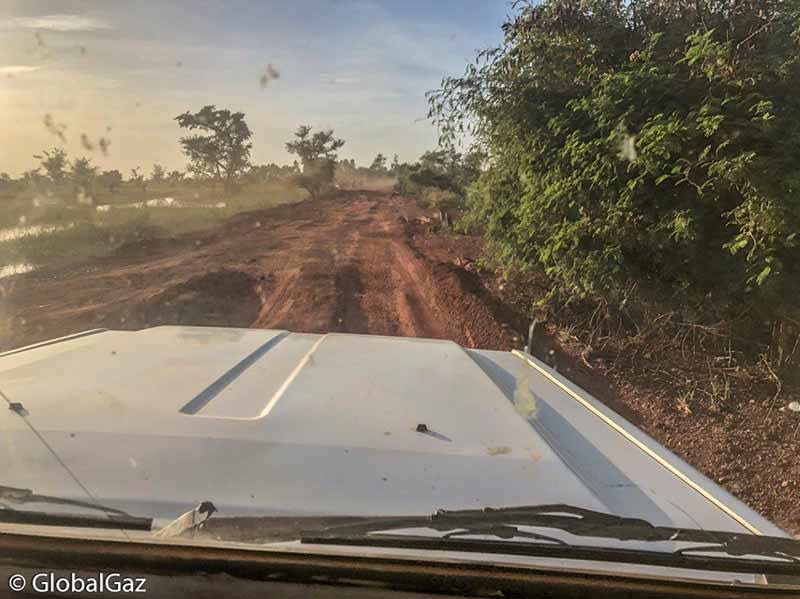
Not the best of roads
A bit later, we passed a lone motorcycle rider. We waved him down and learned unfortunately that the road ahead was in poor condition. We now had to double back and take an alternative route. The route was longer, but supposedly the road was in better condition.
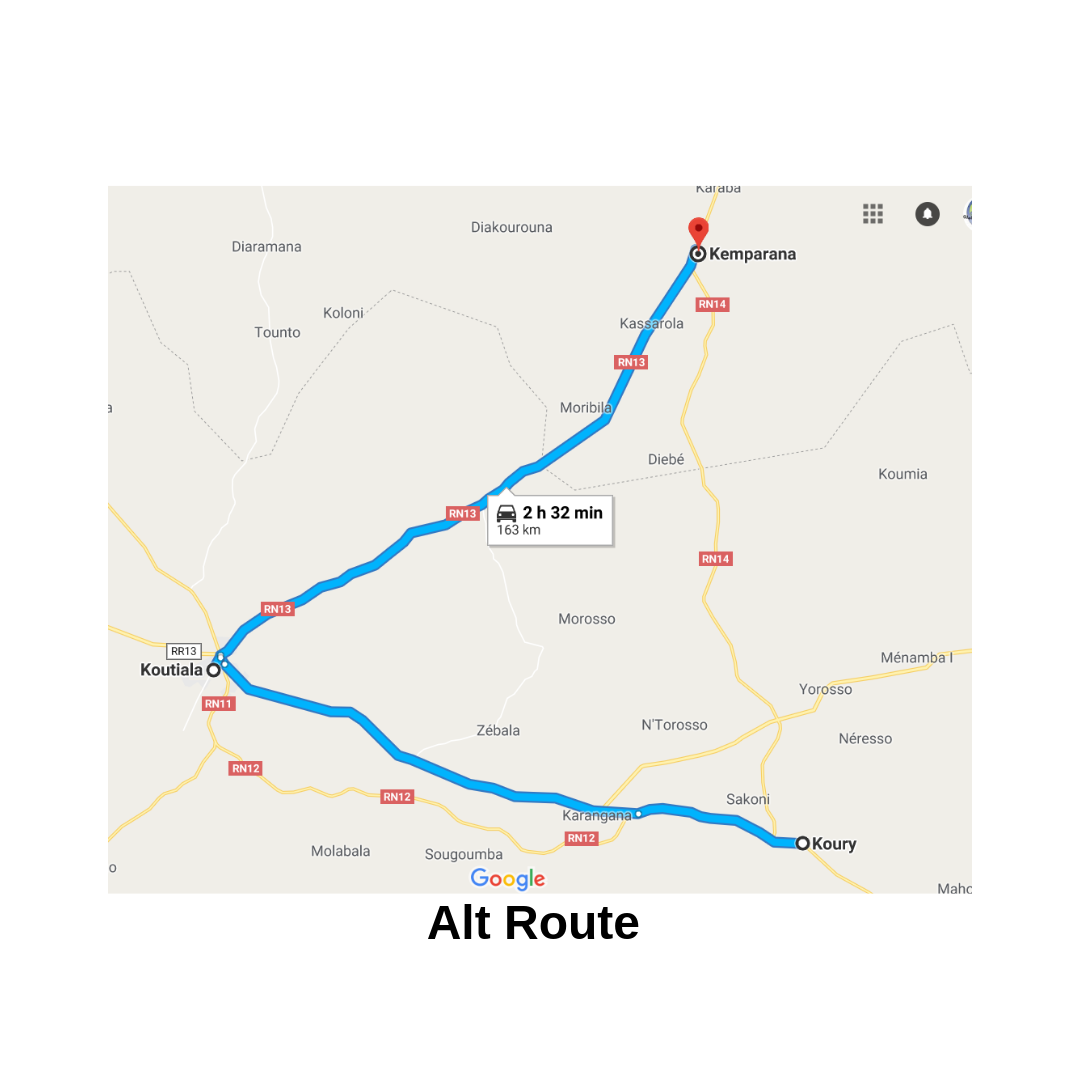
We pointed the car west to Koutiala. The roads were mostly empty, with the occasional donkey and cart outnumbering the occasional car or truck. The sun was bright with blue skies as we passed the occasional brown-mud village. The temperature soared near 100 F (but don’t worry, it is dry heat) as I sweated in the un-airconditioned car.
In approximately one hour we made it to Koutiala, where I dined on a lunch of bananas, and then headed east to Kemparana. My West African roadtrip was not a luxury holiday outfitted in a 2018, $90,000 Range Rover, staying in resorts, and dining at the finest restaurants. Marlon’s car was a beast, a Toyota Land Cruiser from the early 1990s with over 600,000 kilometers. Lunch and sometimes dinner would be bananas from side of the road smeared with some peanut butter that I had brought from home while driving to our next location.

Banana time
On average, my hotels were averaging approximately $30 a night. None were great, and thankfully none were too bad. But my favorite was asking the staff for a sheet for the matress. I then spent 10 minutes arguing with the staff who were insisting that the bed sheet was already on the bed. It wasn’t. It was a mattress pad.
We sped down the road and after another hour, we arrived in Kemparana. We had returned to the northerly road that would now take us in the direction of San. Driving another hour north, we made it to a small, dusty village that was at the fork in the road. A short drive further north was the town of San (this was Plan A). And the road east would bring us to Djennen known as Plan B.
We hopped out of the car and approached the policeman at the check point. After sharing with him that we were traveling to Djenne, he scrunched his eyebrows and he stated that Djenne was in the “secteur rouge” better known as the red zone, as in don’t visit. I am not much of a Frech linguist, but I knew secteur rouge was not a great indicator.
Marlon and I returned to the car. Listening to the policeman did not fuel my confidence. I whipped out my iPhone and searched for the travel advisory for Mali from the US State Department. I am not sure why I had not done this previously and had waited until the final hours.
A lump grew in my throat as I read the travel advisory. I take the State Department information with a grain of salt since the information can sometimes be broad and conservative. But, I grew a bit anxious. In bright red, the advisory states Do Not Travel. It read: “Violent crimes, such as kidnapping and armed robbery is common in central Mali” (where Djenne located). “Terrorist and armed groups continue plotting kidnappings and attacks in Mali. They may attack with little or no warning”.
I continued to read and my confidence waned. The advisory continued: “If you decide to travel to Mali, draft a will … and discuss a plan with loved ones regarding care/custody of children, pets, property.” Wow, that was sobering.
Marlon looked at me. “What do you think? Plan A, Plan B, or should we skip Djenne all together?” I looked at my watch again, and I lamented the two hours we lost earlier in the day. I considered Plan B, but I realized Djenne was 134 kilometers away and we also had the variable of the ferry. The other challenge was it was highly unadvised to travel after sunset (which was around 6 pm). We had the additional risk of being stranded on the road during the night.
I weighed the information again. I thought of the travelers who had visited Djenne recently. And then, recalled what Phil said about his kidnapped clients, the policeman warning us about the red zone, and the chilling words from the US State Department.
I looked at Marlon and with a slight sigh, I told him to head to Djenne. It as going to be Plan B. I was too close to this historic UNESCO sight. We sped off and headed east to Djenne. Google Maps informed us that our ride would take approximately two and a half hours. There was no time to spare. It was going to be close.
The road was fairly good. The roads were mostly empty with a mix of the occasional truck, bike, and donkey. We passed villages with locals gathered by the side of the road, hiding in the shade.
After a hour plus, we turned left and headed on the final road to Djenne, and after some time, the dusty and sparse savannah transitioned into a watery marsh. The narrow road became a raised berm with the water on both sides. My paranoid imagination began to wander as I recalled the State Department warnings. On the raised berm, the car had no room to maneuver. I peered behind the trees abutting the road looking for potential attackers. To calm my paranoia, I reasoned my visit to Djenne would be quick. Before anyone knew I was there, we would be gone.
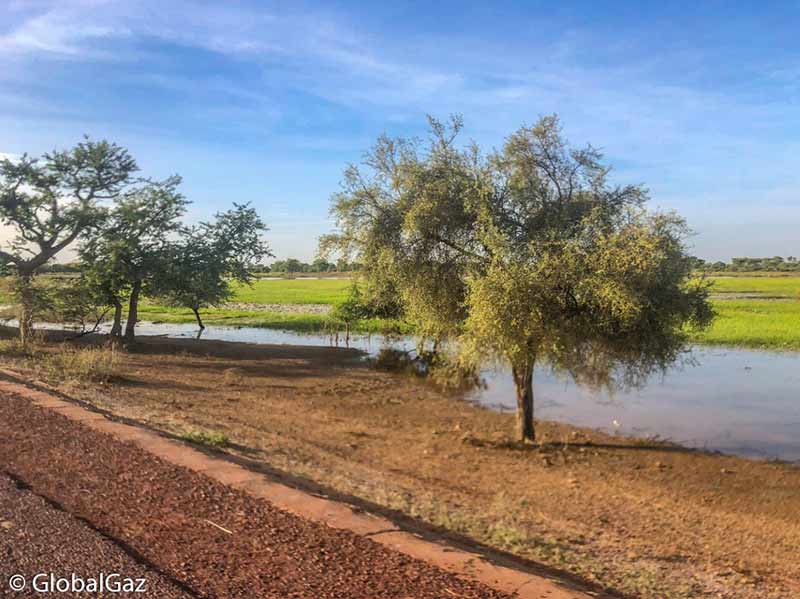
Driving on the final stretch of road to Djenne, waiter on both sides.
The Gods smiled. We approached the ferry and it was magically waiting for us. And there was room for one more car, ours. The brief ferry ride was tranquil, as I stared at the placid river with wooden pirogues floating by as the sun began to set. We were only several kilometers from Djenne.

The ferry heads to Djenne.
Marlon and I drove towards Djenne and kids beside the road chanted in unison: toubabou. Toubabou in the local tongue, Bambara, translates into white person. I crouched down in the seat, realizing my master plan of “getting in and getting out, before they even knew it” had abruptly been aborted. I imagined the kids spreading the word that a foreigner was entering Djenne. Time for my kidnapping.
Djenne is an ancient city that was instrumental in the trans-Saharan trade between the 15th and 17th century. Goods of salt, gold, and slaves passed over these deserts. Djenne’s prosperity began to wane when the Portuguese began to build ports on the Atlantic Ocean of west Africa, which chipped away at the trans-Saharan trade. But, Djenne traces its history centuries before, back to 250 BC.
We entered the compact old city. The drive had taken over 10 hours. The roads immediately transitioned into sandy and dusty, narrow paths. As dusk approached, I felt 1,000 eyes on me as the locals peered at me. My masterplan had definitively slipped away, there was no way I was blending in.
Despite my slight discomfort I was wowed by my surroundings. I was aware that the Djenne Mosque was constructed with mud bricks, but I did not know the entire town was built in the same style. I immediately felt like I had been transported 500 years back in time.
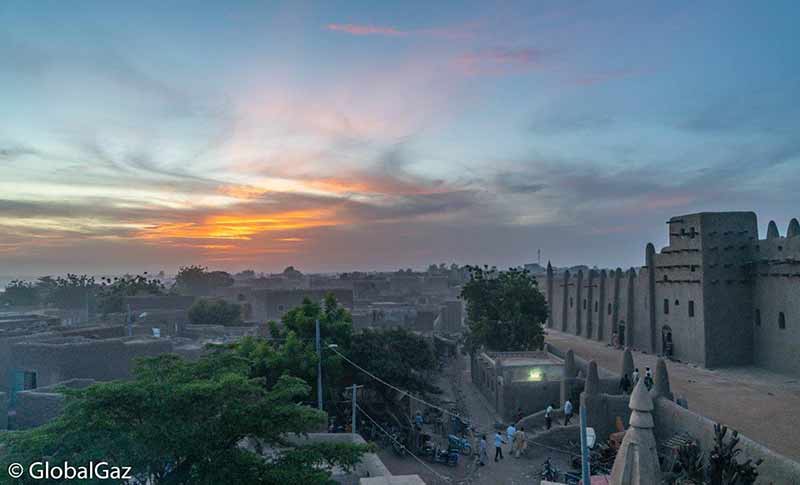
Djenne, from above at sunset
We twisted around the dirt paths toward the Hotel Le Campement as I followed Google Maps. Tourism has virtually disappeared in Djenne and the region. There were not a lot of hotel options, as some had closed due to the tourism drop-off. Only three hotel options appeared on Tripadvisor; all apparently closed. But with a couple more Google searches I found Hotel Le Campement, yet when we arrived, the hotel was not there. Google Maps had misplaced it.
A man approached us as we visually searched for the hotel. He explained to us in French that the hotel was just down the path. We pointed the car in that direction, and I noticed he was following us on his motorbike.
We walked into an open courtyard of the hotel and negotiated for our rooms. My room had seen better days and had a distinct odor of a backed-up sewer. But there were not too many options and I paid the stiff 20,000 CFA ($34) price.

The hotel has seen better days
There was less than 45 minutes of light before nightfall and I was focused on setting my eyes on the Djenne Mosque, which was conveniently only a few minutes walk. The man who followed us to the hotel was waiting for us and insisted that he should be our guide. And I agreed.
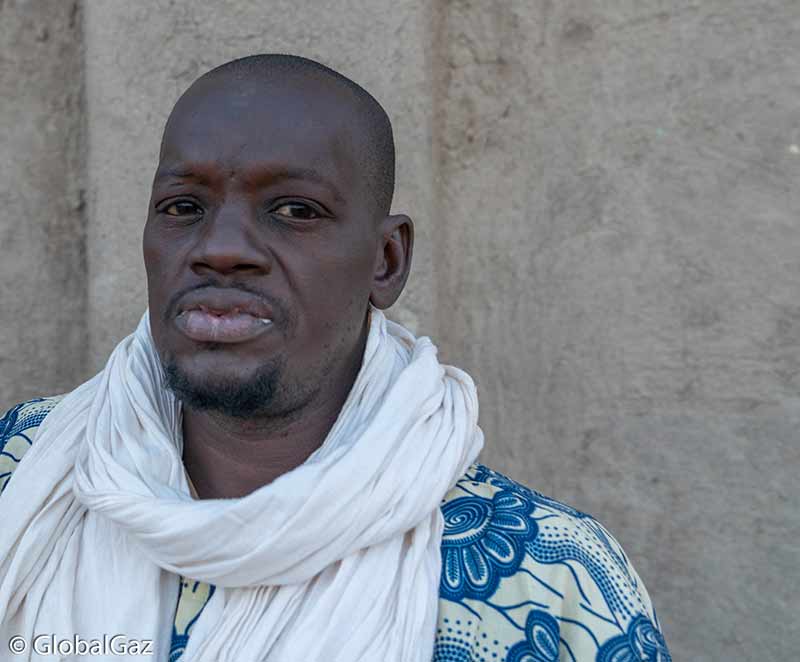
The guide, Monsieur Boss (not looking happy)
We hurriedly walked to the mosque as I kicked up dusty sand. I noted that our guide was known by all the townspeople. Greetings of “boss, salaam” and “boss, ca va?”. With no encouragement I began to call him Monsieur Boss.
I stood on awe in front of the mosque in a large open courtyard. In front, three minarets stood sentry.
Men walked to the mosque in preparation for evening prayer. Children swirled around me in excitement, smiling and waving. I milled around, taking pictures at different angles. I noted a second swirl of children and somewhat shocked, I realized I was not the only foreigner in Djenne. I walked over to greet and introduce myself to Tony, a traveler from China. We parted ways and Monsieur Boss led me to an apartment building adjacent to the mosque. We climbed up the darkened staircase as I peered into the open apartments until we arrived on the roof. I had an amazing view of the mosque as the sky turned dark.
We shuffled back in the direction to the hotel to a restaurant, possibly the only open in one in Djenne. Oddly enough a group of kids were practicing Tae Kwon Do in the courtyard next to the restaurant. It was an open-air restaurant and the only other customer happened to be Tony and his travel companion, Ikky, also from China. Ikky has traveled to over 100 countries and is a seasonal safari guide in Kenya when she is not traveling. I dined on lukewarm spaghetti as we traded travel stories.
I retired to my room and showered, wiping off the thick dust and dirt.

Shower time!
I was full of nervous energy and eventually fell asleep sometime after midnight. I woke at 5 am, still filled with the same nervous energy. I was excited to return to the mosque, but I was also anticipating my departure from Djenne to the relative safety of Sejou, where I would be sleeping that evening.
I exited the courtyard and Monsieur Boss was waiting for me as planned at 6:30 am. I stood again in the courtyard facing the Djenne Mosque. But the courtyard was nearly empty while I was greeted by an early morning clear blue and white sky. I then returned to the roof of the apartment building to capture more shots of the mosque.
Monsieur Boss then led me to the mosque as we entered for a private tour.

One of the entrances of the mosque
It was a bit surreal as I passed the darkened corridors of this mud mosque. I had the entire place to myself. The Djenne Great Mosque was constructed in 1907. There have been several iterations of the mosque over the centuries, with the first one built most likely in the 13th century. This mosque is the largest mud-built structure in the world and stands as a testament to Sudano-Sahelian architecture (Sudan and the Sahel). The mosque is constructed with sun-baked, earthen bricks made with mud and straw. The walls are then plastered over providing for a smooth exterior. The mosque rises to a height of over 50 feet. Walking through the mosque, admiring this holy structure, it was sometimes difficult to imagine this sturdy structure was created simply from mud bricks. Besides the mosque, the entire old city was constructed in a similar manner. The mosque has been erected on a large platform measuring 75 meters by 75 meters (246 feet by 246 feet) which is elevated by 3 meters (9.8 feet). Djenne is hot and dry, but there is a rainy season. And since the mosque is constructed of mud, the rain erodes the structure. The mosque requires upkeep and there is an annual festival known as the Crepissage de la Grand Mosquée. During this festival the entire community comes together to re-plaster the mosque to prepare it for the next rainy season. I fantasized about attending this event.
I was led into the interior, and I paced the corridors where the prayer rugs were placed five times a day.
I was brought to the roof for a bird’s-eye view and stood next to the three stately minarets.
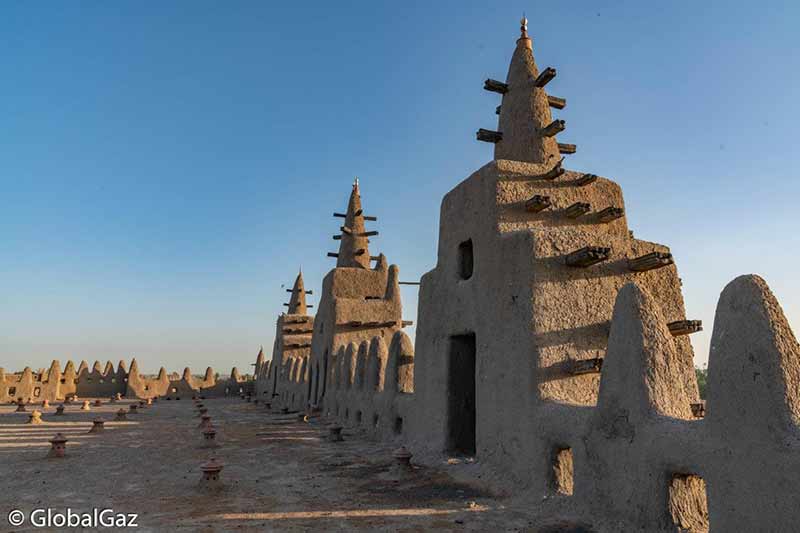
The view from the roof
I then strolled in the rectangular interior courtyard and gazed at flock of pigeons darting through the open expanse. I spied an ostrich egg, a symbol of fertility, that was perched on top of the minaret.
And I admired the fine details of the mosque.
With Monsieur Boss, we exited the mosque and began our walking tour of the old city. Every second person in town greeted my guide. We twisted down sandy paths and alley ways watching the town wake up and begin their day. I was greeted with some smiles, bonjours and salaams. I admired the traditional mud structures.
We returned to the hotel, retrieved our bags, and headed out to the ferry, beating the heat of the mid-day. The ferry loaded up its last car, and the ferry drifted lazily across the river. I smiled, a sense of relief, but more for a gratefulness that I was able visit the historic town of Djenne.
During my trip, I was safe and the people I interacted with in Djenne were friendly. So security warnings need to be taken into account with additional research before you travel. But the take-away is, it is safe until it isn’t.
And how to get to he historic and cultural city of Timbuktu? Click here.
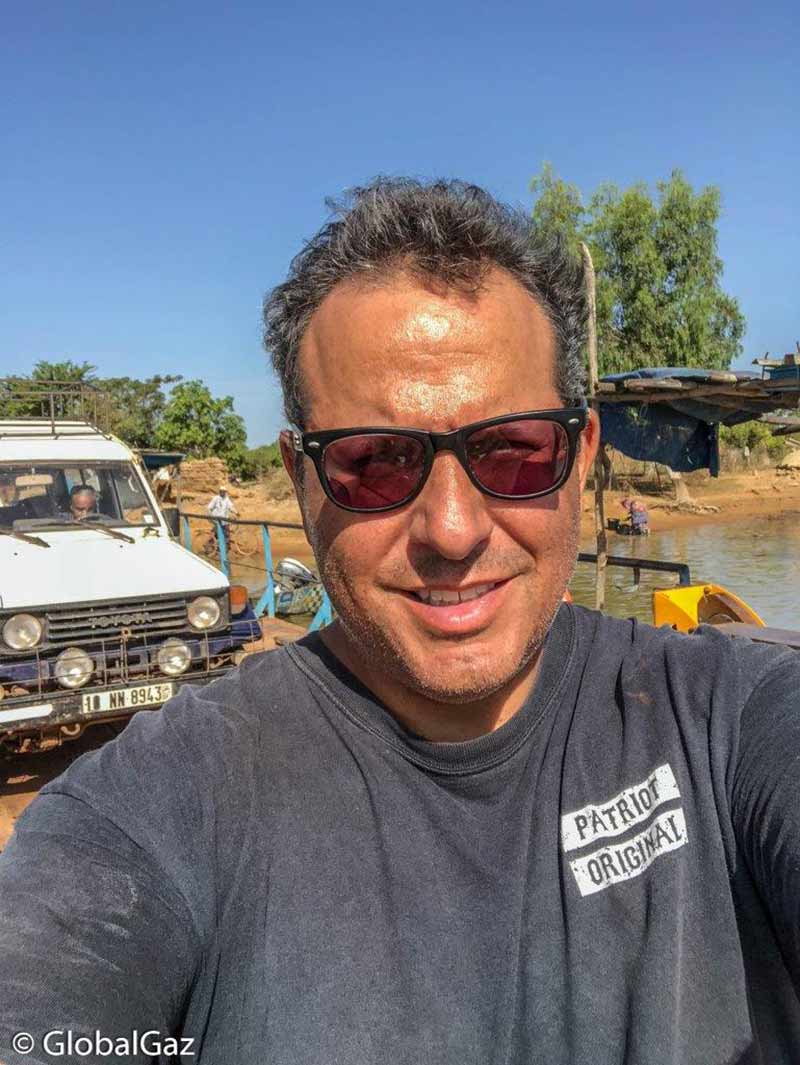
Feeling relaxed as the ferry departs Djenne
Visiting Great Mosque Djenne Mali
Visiting Great Mosque Djenne Mali
Visiting Great Mosque Djenne Mali

Photos From Chernobyl
Sign up to receive your free copy of Photos From Chernobyl. Over 100 photos from the Chernobyl Exclusion Zone.

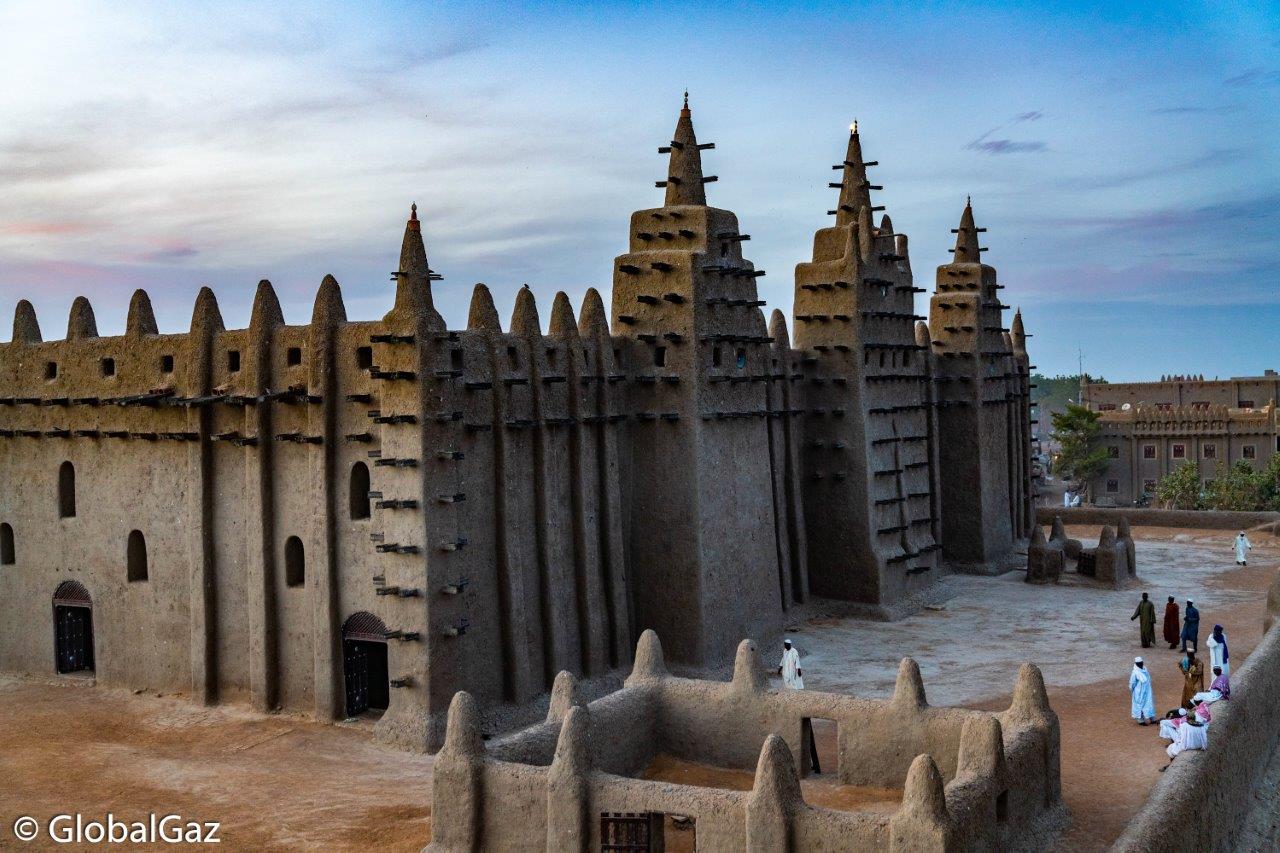



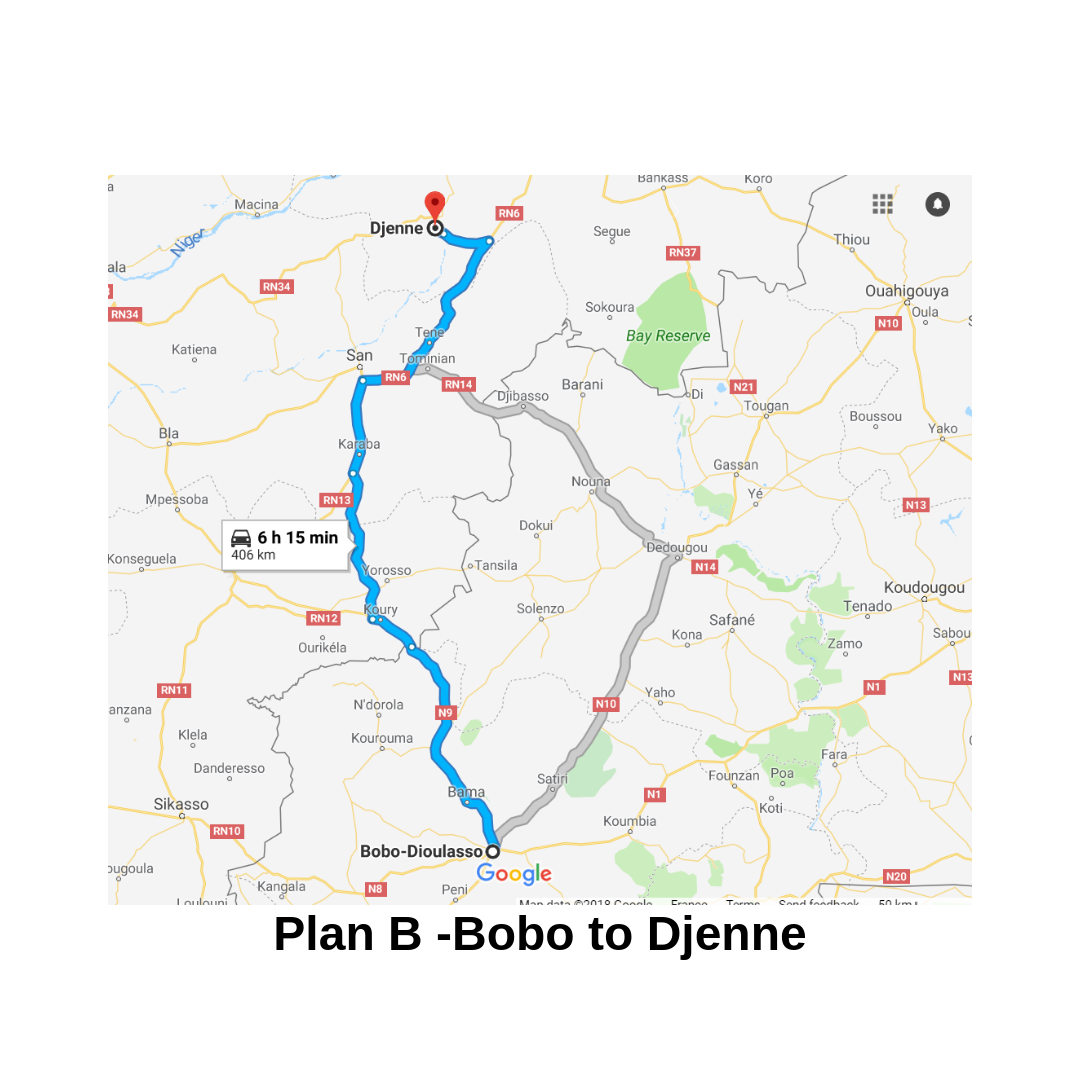


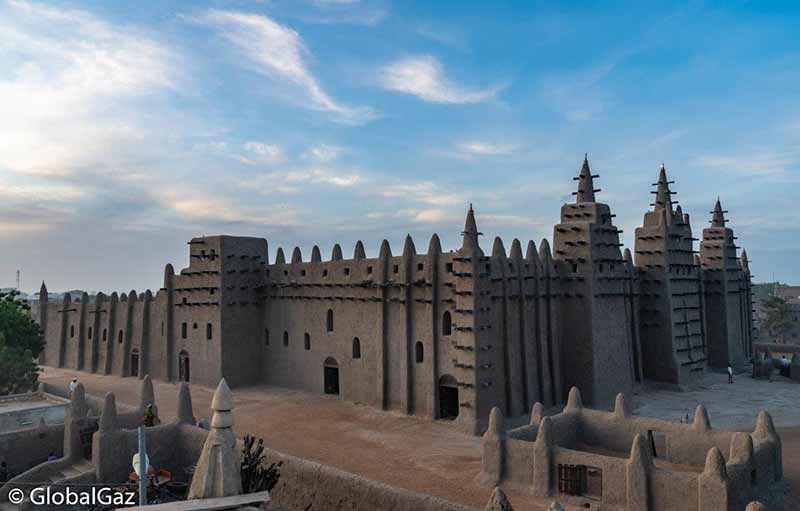


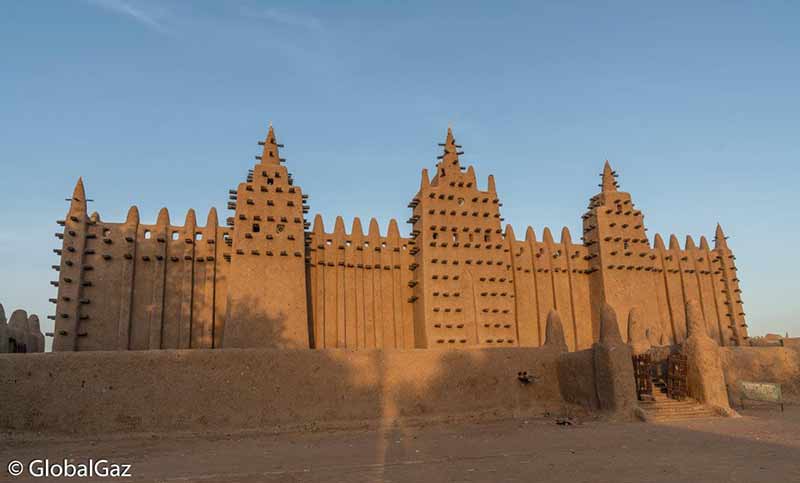










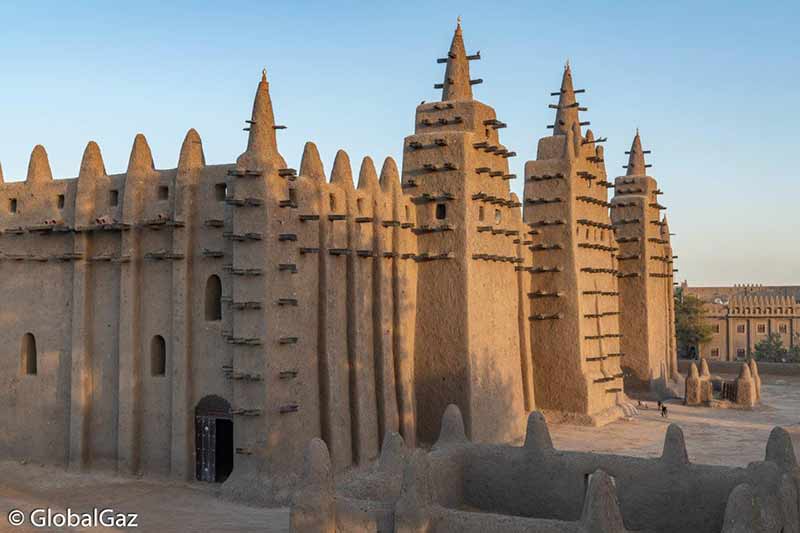



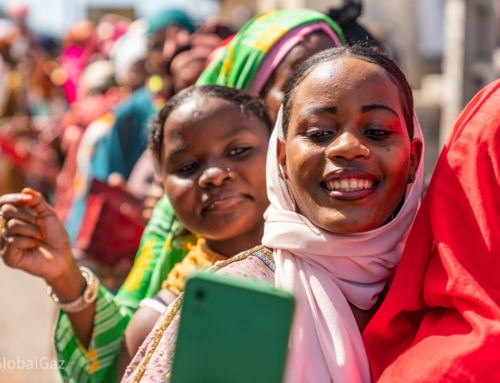
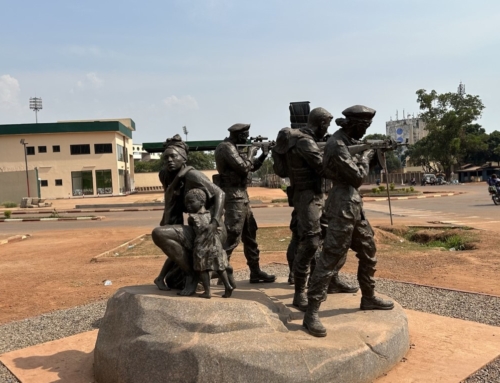

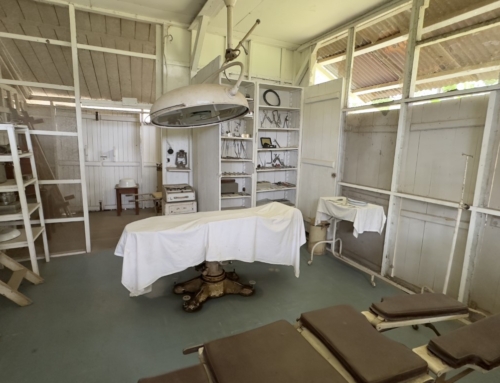
[…] Gaz visited The Great Mosque Of Djenne, Mali. Pretty impressive […]
Wow, it is spectacular Ric. I’m sure you’re incredibly happy you went and made it out.
I got paranoid just reading it. Looking at the photos I also see a bit of wariness in the eyes…I don’t know how comfortable I would have felt staying a 2nd night…
I’m amazed by the mosque.
Yeah, it was truly spectacular…very very happy I was able to see. And a bit of a sense of relief to leave. It is quite sad, because the region has so much to offer but the security environment is a bit lacking in the region.
Djenne is spectacular. I was there in 2005. Back then I was able to use public transport to get around.
It really was. Glad you were able to go. I actually met a Chinese guy and girl who were on the bus. They were more brave then me.
Mali is easy to travel around by public transport. I don’t see what is “brave” about getting on a bush taxi, motorcycle or bus.
[…] Mali. A climatic way to finish off my 2018 travels was my visit to Mali. I visited the old city of Djenne and witnessed the Great Mosque, constructed of mud and considered the largest mud structure in the world despite a somewhat challenging security situation. […]
Wow! I spent two weeks in Mali traveling around a bit, but did not do my research beforehand. I ended up in a bunch of random villages in the Western half of the country (I entered from Burkina Faso). I now do my research before going anywhere so I don’t miss places like Djenne which I just learned about from your blog. Sad Mali is having its muslim terrorist or rebel problem (whatever you wanna call it). I found them to be some of the nicest people (at least the people in the Western half of the country). Looks like I need to make a 2nd visit.
Cool, what were the villages like in the west? I left from Bobo, and was driving through them, but did not spend any time there.
Djenne was magical. And the people were nice. So, if possible head back. It is a special place.
[…] Read the full post: Visiting the Djenne Grand Mosque […]
[…] Read the full post: Visiting the Djenne Grand Mosque […]
What a fascinating and detailed account of the visit including the challenges and decision making you faced, really enjoyed it, thank you!
Thanks, it was a great road trip!
[…] walled city. The card roads wheeled trough the deep sanded roads and then I stood in front of the Grand Mosque in gratifying […]
[…] mud and brick buildings begin to glow in the dawn light, Timbuktu comes to life. Read more about visiting the Great Mosque of Djenne, in […]